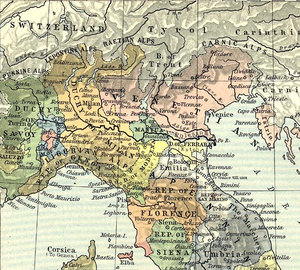League of Cambrai
Topic: Organization
 From HandWiki - Reading time: 3 min
From HandWiki - Reading time: 3 min
League of Cambrai | |
|---|---|
| 1508–1511 | |
 Northern Italy in 1494. | |
| Status | Military coalition |
| Membership |
|
| Historical era | Early modern period |
• Established | 10 december 1508 |
| 24 february 1511 | |
The League of Cambrai was a military coalition against the Republic of Venice formed on December 8, 1508, by the main European powers (Holy Roman Empire, Spain and France), to mantain the hegemony on the Italian peninsula.
Membership
Joined the League: Maximilian I (Holy Roman Emperor), Louis XII (King of France), Ferdinand II of Aragon (King of Naples and Sicily), Julius II (Sovereign of the Ecclesiastical State), Alfonso I d'Este (Duke of Ferrara), Carlo III (Duke of Savoy), Francesco II Gonzaga (Marquess of Mantua) and Vladislaus II (King of Hungary).
Aim
In the treaty's preamble, signed in Cambrai (a small city located in Hauts-de-France) with the pretext to achieve a peace between the Holy Roman Emperor and the Duke of Guelders, to which were admitted also the Spanish and Papal ambassadors, we read that it was stipulated:
[...] to stop the losses, the abuses, the robberies, the harms which the Venetians have caused not only to the Holy Apostolic See, but also to the Holy Roman Empire, to the House of Austria, to the Dukes of Milan, to the Kings of Naples and to many others principles occupying and usurping tyrannically their goods, their lands, their cities and their castels, as if they had conspired to the ill of everyone [...] So we found not only useful and honorable, but also necessary to call everyone to a right revenge to turn off, like a common fire, the Venetians' insatiable greed and their thirst for domination.
The Treaty of Cambrai predicted the next Venetian dominions' spartition:
- to the Holy Roman Empire: Treviso, Padua, Vicenza, Verona, the Friuli and the Istria
- to the Kingdom of France: Brescia, Bergamo, Crema, Cremona and the Gera d'Adda
- to the Spanish Empire: Trani, Brindisi, Otranto and Gallipoli
- to the Papal States: Ravenna, Cervia, Rimini, Faenza and their castels, and also some possessions near Cesena and Imola
- to the Duchy of Ferrara: the Polesine, Este and Scodosia di Montagna
- to the Marquisate of Mantua: Peschiera, Asola and Lonato
- to the Kingdom of Hungary, if it joined the alliance: Dalmatia
- to the Duchy of Savoy, if it joined the alliance: Cipro
The conflict
The Republic of Venice had lots of inklings of a possible alliance against itself, due to some speaches of the French ambassador.[1]
The League fought the Venetian forces between 1508 and 1511. After they routed the Venetian army in Battle of Agnadello, they invaded Veneto and marched to Venice; however, they get defeated by Bartolomeo d'Alviano in the Siege of Padua. So, the Venetians resisted and launched a counter-offensive, taking back a big part of Veneto but getting defeated in the Battle of Polesella.
In 1510, the Pope Giulio II decided that the France consisted in a bigger threat for the Italian peninsula's balances than Venice, so he left the League to switch with the Serenissima. The next year, the Spain and the Holy Roman Empire switched side, too, leading the foundation of the Holy League against France.
References
- ↑ von Hormayr, Josep Freiherr (1821) (in it). Massimiliano I. Il Plutarco austriaco ossia Vite e ritratti di tutti i sovrani della casa d'Austria e dei più rinomati generali, uomini di stato, letterati ed artisti dell'impero austriaco. 2. p. 238.
Sources
- Mallett, M. E. (2006). The Military Organisation of a Renaissance State: Venice C.1400 to 1617. ISBN 978-0521032476.
- Marocchi, Massimo (2010) (in it). I Gonzaga e Lonato 1509-1515. Brescia.
- Chiappini, Luciano (2001) (in it). Gli estensi. Storia di mille anni.. Ferrara. ISBN 9788882690298.
- Locatelli, Francesco (1985) (in it). La fabbrica ducale estense delle artiglierie. Bologna. OCLC 18349517.
External links
- "Cambrai, Lega di" (in it). 2010. https://www.treccani.it/enciclopedia/lega-di-cambrai_(Dizionario-di-Storia)/.
- "League of Cambrai". https://www.britannica.com/topic/League-of-Cambrai.
 |
 KSF
KSF